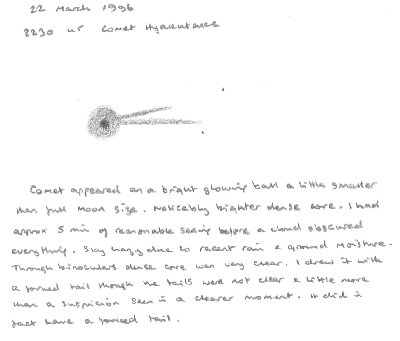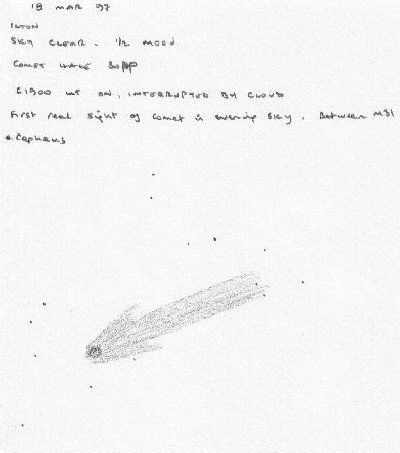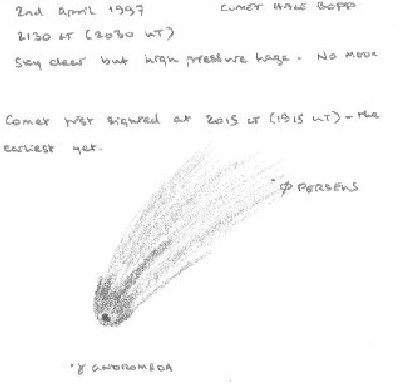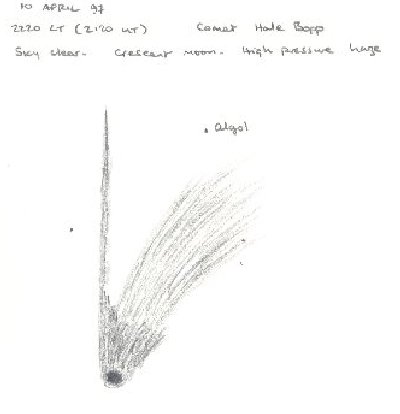

I'm going to return to Jupiter and Shoemaker-Levy 9, but first let's take a closer look at two comets that we definitely did see, Hyakutake and Hale Bopp. I'm going to deal with them together because they overlap in time and there are interesting comparisons to be drawn.
Hale Bopp was the first of the pair to be discovered, in July 1995. It was near M70 in Sagittarius at 11th magnitude then, though it was then discovered retrospectively on a photographic plate from April 1993, when it was at 18th magnitude.
By May 1996 it was brighter than expected after passing behind the Sun, and by then everyone had realised that Hale Bopp just might turn out to be something rather special. There was, however, the possibility that the brightness might be an outburst that would quickly exhaust the volatile material, and it all might just fizzle out.
Only a few months before that, in January 1996, Comet Hyakutake was discovered. If you remember it, Hyutake was the one that came and went very quickly. Only discovered in the January, it became visible to us just two months later. I first saw it on 22nd March near Arcturus. You may also remember that the weather then was not very good for comet watching - lots of cloud. I first saw it through breaks in the cloud, but I formed the opinion that it had a forked tail. The very next day a photograph of it appeared in a newspaper, and it did indeed have a forked tail at that time. Hyakutake's tail was never very impressive in the way that Hale Bopp's would be, and I'll explain that later.


By 27th march Hyakutake was romping its way rapidly across the Polaris region, with a single tail, well spread and thick, straight and fairly faint. Look at the drawing and you'll see a brighter core within the tail. Possibly this might have been a perspective effect of looking at two tails superimposed on each other. Brighter areas in the coma could be material newly ejected from the nucleus.


Three weeks later, when the comet was in Perseus, the tail was long and thin, showing very well, if faintly, how the shape of the tail changes with the comet's position and the perspective with which we vew it. The nucleus, too, had become very small and condensed. Soon after that Hyakutake was gone, probably for the next 12000 years, leaving those of us lucky enough to see it through the cloud cover eagerly waiting for Hale Bopp.
Probably Hyakutake raised expectations for Hale Bopp. It was a bit of a warm up act, was Hyakutake, which was a shame because it was a spectacular comet in its own right.
I saw Hale Bopp in July 1996, first through a half metre telescope in Portugal, and when I returned through my humble little six inch from my garden. The photograph I took then is reproduced as a header to this article, and you'll see that it looked very different to the way we were to see and remember it, but it did already have a small tale and it's quite clear how material from the nucleus is being swept back into it.
Interestingly enough, my notes from my observations of it at home state that while I was sweeping an area in Scutum looking for Hale Bopp I came across another fuzzy object that might have been Comet Kopff. Certainly Comet Kopff was around at the time, but the significance of this comment lies in the fact that comets are actually around quite regularly, in fact most of the time, but apart from the very occasional one or two they remain very faint telescopic objects like Kopff was.
I followed Hale Bopp as it became a binocular object until late in the year when it disappeared into twilight. By then it appeared to me to have stopped brightening, which was a little worrying, but there was nothing to do except wait until February of the following year, 1997, when it would reappear in the early morning sky.
My first sighting of 1997 was on February 8th at 5 in the morning, and my notes for that day as I watched the comet with its short, thick fan of a tail, read: 'When last seen binocular object appeared to have stopped brightening. Observer roused from bed and cat, bleary eyed and standing outside house on frosty morning in pyjamas, dressing gown and slippers.' Some of us don't like early mornings, even for comets. Three weeks later the tail was longer, brighter, and had a prominent centre. On March 18th it was in the evening sky. The nucleus had brightened and the tail was longer and thinner, but all my observations at this point had been plagued by cloud. By March 29th the tail was curving. In binoculars it was bright enough to show colour - a greenish tinge - and even the plasma tail was faintly visible.






The last drawing I have reproduced here shows the plasma tail a lot more distinctly that it actually was visually, but it shows how straight it was compared to the curving dust tail. The bow waves were a curious feature which I'll discuss later, and the blotch of brighter material might be some sort of outburst or perhaps a piece of the icy, dusty crust breaking away. Hale Bopp showed features telescopically that I have never seen before or since.
The last time I plotted Hale Bopp's position was on April 16th, when it was in Perseus and heading for Taurus. So much for the observer's record. Anyone who watched both Hyakutake and Hale Bopp probably noticed that there seemed differences in the way the two comets appeared, and indeed they were very different.